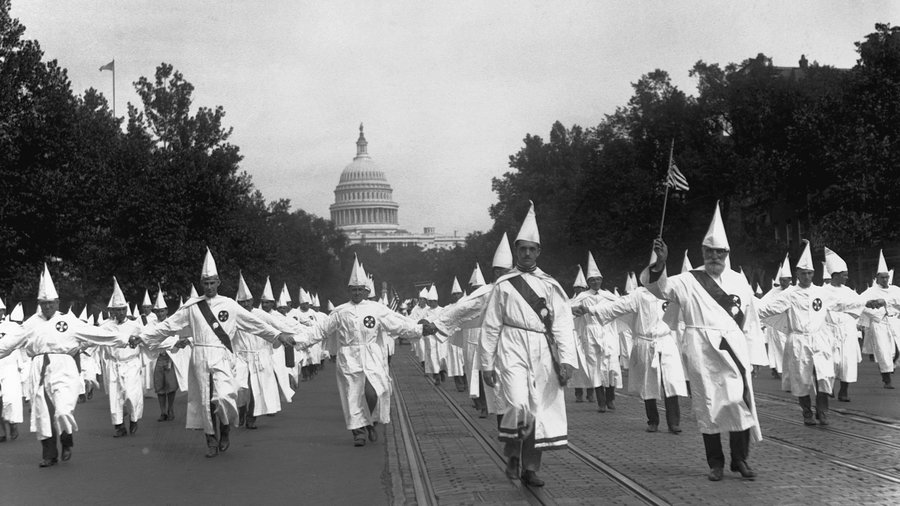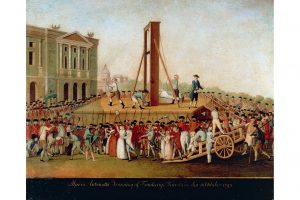Since its origins, the infamous Ku Klux Klan has influenced the attitudes and views of many Americans. The KKK will forever be recognized as the largest political hate group in United States history. Despite the rise and fall of the Klan, it wasn’t until the 1920s that it rose to its highest peak in prominence. During this time period, there was exponential growth in both membership in and support for this notorious cult. The KKK was a growing cult in the 1920s because it instilled religious beliefs, terror, and a skewed view of a better America into the minds of its members through its propaganda of racial superiority.
The original KKK arose during the Reconstruction era of the 1860s and 1870s, and was primarily aimed at restoring the antebellum racial hierarchy to the South. However, it declined in the 1870s due to the passing of legislation aimed at stopping Klansmen’s voter intimidation activities and associated hate crimes. With the end of Reconstruction in 1877, and the passage of Jim Crow laws throughout the South, Klan activity and Klan membership declined. But the cult began a strong resurgence in 1915, with membership skyrocketing to nearly four million by the year 1920.1 This time, the focus of their efforts was aimed at “Americanizing” people by promoting the Constitution, the flag, and the Bible.2 This white supremacist organization lashed out at any group whose ideals conflicted with their own, especially that of African Americans, Catholics, and Jews.

The revival of the Klan was led by its notorious second Grand Wizard (the KKK’s primary leader), William J. Simmons, who was a preacher, a veteran, and an extreme white supremacist.3 He was inspired to reorganize the Klan after watching the silent movie Birth of a Nation, which depicted the Klan as a saving grace, defending the birthright of white southerners and greatly enhancing the public opinion of the cult.4 The religious implications of the KKK stemmed from the teachings of Simmons. Not only were his sermons effective at grasping the hateful minds of Klan members, but he truly convinced them that they were doing the work of God; his credibility led him to a position of power. In fact, one could not join the Klan unless one practiced “militant Christianity,” living in such a way as to be an example to others by following laws, abstaining from drinking, gambling, infidelity, and by not neglecting one’s family. Members were to attend church services regularly, always adhering to the foundations of the Christian faith.5 In addition to this, the KKK burned crosses, often arguing that it was to symbolize the spread of Jesus’ light; it was a symbol aimed to “drive away darkness and gloom.”6 The heavily emphasized morals and negative attitudes toward others are what drove the cult’s frame of thought. Often interpreted in a hateful manner, the religious implications instilled by the KKK’s leaders too often brewed inaccurate thoughts in the minds of its followers; thus, many assumed that the answer to their problem was to commit radical acts of terror.

In addition to their cloaking themselves in the trappings of Christianity, the Klan also used terror tactics to instill fear into both its own members and to those it targeted. The members saw themselves as vigilantes in the restoration of justice—using intimidation, violence, and terror to prevent people of color from attaining any sort of social status or political power. They burned crosses, led beatings, committed assassinations, lynchings, and much more.7 While the symbol of the KKK, the burning cross, held religious connotations for its own members, it was also used as a form of intimidation. They used this symbol of a burning cross to terrorize African Americans.8 In addition to intimidating African Americans, the Klan also targeted Catholics, and had a particularly strong concern with this group due to the fact that they practiced a “different religion” from their own. The motivation for this anti-Catholicism is deeply rooted in American history, going all the way back to colonial times. And with the dramatic increase of Catholics immigrating from Ireland, Italy, and Germany in the nineteenth century, anti-Catholicism was a mainstay throughout American life in the early decades of the twentieth century.9 With the ethnic, social, and racial diversity of American life, tensions continued to heighten among the opposing whites who sought to rid America of these many “outsiders” — a long-held notion in American society. In using both verbal and physical threats, the terror inflicted by the cult caused people to fear the power of the invisible empire that was the KKK.
The idea of creating a better America was yet another reason for the Klan’s rise to prominence in the 1920s. The KKK fought for stricter enforcement of prohibition laws, sought to eliminate political corruption, and wanted to eradicate any form of immigration. Any seemingly “foreign-born” citizen that crossed the path of a klansman was deemed un-American. The Klan assumed they were doing the nation its due diligence in suppressing these “outsiders.” At its peak, the Klan even managed to get political leaders to seek their support and endorsement, since many Americans at this time sympathized with the Klan and its mission.10 And as membership grew, so did their influence. Their opposition to non-whites and to immigration helped to secure the passage of strict quotas on those seeking to come to America.11 The KKK was influential in more ways than one — their power reigning heavily on American society. Even today, white supremacists seek to have their voices heard and their views seen as legitimate. The fight for racial toleration is certainly far from over.

On the other hand, some say that the resurgence of the KKK in the 1920s was due primarily to the effects of industrialization, urbanization, and immigration on society. White Americans became uneasy about immigration and “outsiders” taking American jobs. Many could not stand the idea of “those people” diluting the “racial purity” of American society. But the idea of racial purity is a myth–yet a strong one that many white racists wish to be true. The original soil of America was populated by immigrants and natives alike; whites simply claimed it as their own, as they were to be the guardians of a “city on a hill” and as part of their “manifest destiny” to be the bearers of a supreme culture and society.12 Those that looked to this cult to justify their own beliefs do not parallel with what it means to be an independent individual in American society. The people they were trying to drive out had just as much freedom to be in the United States as they did. Others in support of the Klan also claimed that Simmons was, in fact, preaching for the betterment of society, and that he never resorted to violence to solve problems; though this may seem true, Simmons was actually insinuating his own, twisted version of the word of God, often emphasizing ideas of white supremacy and racial segregation as if that was God’s will. In a pamphlet he wrote in the early nineteenth century, he even states that the primary goal of the organization is to preserve ideals of pure Anglo-Saxon civilization, and many claimed he preached themes of being a pro-American leader by hinting in his sermons that any person in opposition to traditional thought of Anglo supremacy was unwelcome, and simply un-American.13 He silently, yet deviously, instilled discrimination into the Klan’s members. It was even noted that Catholic priests, Protestant ministers, and Jewish rabbis came forward to condemn the organization and its false teachings.14 It seems that the religious implications, terroristic acts, and the skewed ideals used in order to insinuate the making of a better America are contradictory to both the Klan’s mission and the symbols they claimed to uphold.
With a religious basis, the Klan movement emphasized legal and political approaches to solving the “moral crisis” in 1920s America.15 The cult rose to prominence in the 1920s because of their religious, terroristic, and “ideal American” implications; however, their resurgence only served as a detriment. The second coming of the Klan was significant in that it rose to its highest peak in prominence. The KKK’s second coming only continued to fuel the long-held idea of hatred and discrimination that still lingers in the minds of many today.
- Khan Academy, 2016, s.v. “The Reemergence of the KKK,” by Dr. Michelle Getchell. ↵
- David A. Horowitz, Inside the Klavern: The Secret History of a Ku Klux Klan of the 1920s (Carbondale: Southern Illinois University Press, 1999), 10. ↵
- David A. Horowitz, Inside the Klavern: The Secret History of a Ku Klux Klan of the 1920s (Carbondale: Southern Illinois University Press, 1999), 11. ↵
- Roland G. Fryer, “Hatred and Profits: Under the Hood of the Ku Klux Klan,” Quarterly Journal of Economics 127, no. 4 (November 2012): 12. ↵
- Holley Donald, “A Look Behind the Masks: The 1920s Ku Klux Klan in Monticello, Arkansas,” The Arkansas Historical Quarterly no. 2 (2001): 19. ↵
- David Cunningham, “Top 5 Questions About the KKK,” PBS, 2013. Accessed March 12, 2018. http://www.pbs.org/wgbh/americanexperience/features/klansville-faq/. ↵
- Khan Academy, 2016, s.v. “The Reemergence of the KKK,” by Dr. Michelle Getchell. ↵
- PBS, 2013, s.v. “Top 5 Questions About the KKK,” by David Cunningham. ↵
- Mark Paul Richard, Not a Catholic Nation: The Ku Klux Klan Confronts New England in the 1920s (Amherst: University of Massachusetts Press, 2015), 11. ↵
- American Decades, 2001, s.v. “After the Great War: Nativism and the Ku Klux Klan,” by Judith S. Baughman, et.al. ↵
- Gale Encyclopedia of American Law, 2011, s.v. “Ku Klux Klan,” by Donna Batten. ↵
- Khan Academy, 2016, s.v. “The Reemergence of the KKK,” by Dr. Michelle Getchell. ↵
- William J. Simmons, “Pamphlet for the Ku Klux Klan Written by Colonel William Joseph Simmons,” Smithsonian, 2017. Accessed April 6, 2018. https://nmaahc.si.edu/object/nmaahc_2011.155.15. ↵
- Khan Academy, 2016, s.v. “The Reemergence of the KKK,” by Dr. Michelle Getchell. ↵
- Holley Donald, “A Look Behind the Masks: The 1920s Ku Klux Klan in Monticello, Arkansas,” The Arkansas Historical Quarterly no. 2 (2001): 14-15. ↵




122 comments
Lamont Traylor
The things that the Klu Klux Klan did were very unnecessary and inhumane. I can’t even begin to understand why human beings would do the things that they did. Honestly, being a African American man I can honestly say that it was tough to read this article and hear about the things that they did to my ancestors and my people.
Eric Ortega Rodriguez
This article was extremely informative. When I think of the KKK, I envision the acts of violence that they did during the 1870’s. That is probably the image they were trying to portray to African Americans. I’d like to give props to the author for writing about this controversial topic that has been prevalent throughout history and even in the past year. I think it’s bizarre how people would alter the word of God in order to suit their personal beliefs. I also found it fascinating to see the power that words have, in the case of William J. Simmons, he was able to ignite an old flame and revive the KKK.
Madison Downing
I love how you took a topic that not many people would want to write, even talk about, and made it so educational on the fact that what these people were doing was scaring people into believing what they wanted. I loved how you focused on the fact that people agreed with them but many found what they were doing wrong. I can’t even believe that they were anti-catholic, they both followed Christianity that doesn’t make a lot of sense to me, but a group like that doesn’t make sense. When people think of the 1920s they only see the flappers, the gambling, yes the war, and alcohol. I an inspired that you did so much research and proved everything you said was factual and not opinionated, you gave the truth and that is extremely respectful. You did such an amazing job and I look forward to reading more of your work!
Ethan Rodriguez
I think that this article is an interesting one for the soul purpose that in society today, we are seeing people that uphold these values. I feel that this organization, was extremely heinous and absolutely terrible. It is undoubtedly one of the most embarrassing points of the human race, trying to eradicate people of different skins colors. Nothing about this clan is short of dictatorship. It makes me feel that the 1920s were not a safe time for anyone. Opposed from my rant, I feel that the author did a great job in discussing such as hard topic to talk about. I feel that the author while relating this article to the past also did a great job at the end tying it back to the society today.
Pedro Gonzalez Aboyte
The power of public speaking and the power of religion is immense and William Simmons knew exactly how to use them to his advantage. It is reminiscent of Adolf Hitler and how he captivated the minds of millions of people to follow his ideology. Like Hitler, Simmons made his followers believe that what they were doing was the right thing and that they were making America a better place. It’s truly saddening that people can be that closed-minded and not accept the fact that America is a country of diversity, and we must have respect and be able to live in communion with others in order to come to come together as a nation.
Christopher Hohman
Nice article. It is unbelievable that an organization that upholds such ideals was ever allowed to be as powerful as it was. A group that became so synonymous with hatred and bigotry had people elected to office, and was allowed to march on Washington. That is sad honestly. The United States has a long way to go, but we have still come a long way since the 1920s.
Tyanne Pearcy
These practices mirror the behavior of a manipulative dictatorship. The complete brainwashing of these followers is the most concerning aspect about the entire group. The method of using religion to insinuate hate towards other groups of people is a contradiction by itself. The sad thing is that these hateful ideas have been incorporated into todays society even in the 21st century. I hope that the world can get past peoples differences and stop negative associations towards groups.
Noah Bolhuis
It is sad that this group took all the teachings of the Christian Church the exact opposite way. Everything this group did was wrong and evil, and they are still the same spiteful group that they were nearly a century ago. I’m disappointed that humanity, and Americans, would drop to such an evil stance on everything, even if the country had just been torn apart. That was the perfect time to let go and try to rebuild, and come together. These people did the exact opposite, and drove a deeper wedge. The KKK, founded by southern Democrats, was, is and always will be an evil hate group. We as a nation can only hope that they see the humanity in everyone, and leave their evil ways.
Ysenia Rodriguez
The power of religion baffles me time and time again. Whenever there is a conflict between two groups of people- whether they be immigrants, people of another race, or people of another religion- preachers of “God’s word” speak in hate and opposition against others and actually get their message across to the masses. These men manipulate their holy books by teaching hate, and of course, acts of hate are easier to perform than standing against oppression with acts of kindness. The fact that William Simmons was able to revive this political hate group by convincing them that “they were doing the work of God” through various acts of terror shows the closed mind of white supremacy in America.
Pamela Callahan
Reading about the second Grand Wizard, William J. Simmons, reminded me a lot of Adolf Hitler and the Nazis. Both leaders convinced their followers that they were doing the right thing and that they were making the world a better place through the destruction they were causing. I find it sad that certain groups of people think that they are more valuable than others when we are all equal and should all be respected for who we are and where we came from.